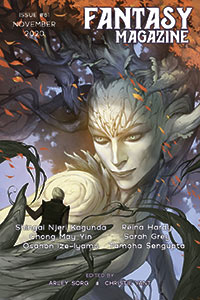The All-Time Top 40: The Pusher, John Varley (#42)
There are many writers who owe a debt to the late Robert A. Heinlein, and many who could legitimately be described as having been greatly influenced by his work. John Varley, who spent the ’60s in Haight–Ashbury in San Francisco, is one of them.
Varley published his first short story in 1974, and then proceeded to unleash a string of stories through the second half of the 1970s and the first half of the 1980s that stand as one of the most consistently impressive bodies of short fiction ever published in the science fiction field. Those stories, which explore similar sexual and social themes to those that Heinlein had touched on his novels of the 1960s and 1970s, are collected in the collections In the Hall of the Martian Kings, The Persistence of Vision, The Barbie Murders, and Blue Champagne.
Varley won his first Hugo in 1979, and his most recent in 1985. The story I’m discussing this week, though, is his 1982 Hugo winner, “The Pusher”. Published in the October 1981 issue of The Magazine of Fantasy & Science Fiction, “The Pusher” explores the social ramifications of a reasonably straight forward piece of science, wrapping it up in a story that is a study in how to write a disturbing piece of fiction.
Ian Haise is a ‘pusher’. He works cleaning the stardrive compartments of a faster-than-light starship that makes regular runs from Earth to nearby trading posts. While each trip only takes several months for those on board, much more time passes at home because of time dilation. With each trip the impact of time passing becomes increasingly devastating, divorcing crew members (who spend their time ‘pushing C’) from people living on Earth (who are ‘pulling gee’).
The story opens with Haise searching for a playground. Immediately Varley has us on edge. When he writes that “Ian liked children”, it suggests something unwholesome. And when he says “Ian concentrated on the girls. He’d tried boys with boys before, long ago, but it had not worked out” alarms bells are going off. He does nothing to silence those bells through the first several pages of the story as he shows Haise’s search for a suitable young girl, his approach to her, and his attempts to win her confidence. Cleverly, Varley addresses the very concerns he raises when Haise considers the safety of the playground and the responsibility of the parents who let them play there. And bit by bit the story dances around the edge of the fear that it introduces – that Haise is in some sense a sexual predator – by showing us first that he has seemingly disturbing intentions, then that he is a likable and normal seeming character, before touching however briefly on the predator angle to make sure we remain on guard. It’s only in the concluding part of the story, when the science fictional aspect of the story has been laid out fully, that he shows us the innocent, if odd, nature of Haise’s motivation.
I first read “The Pusher” when it was collected in Blue Champagne in 1985, and to be honest I didn’t really remember it. I think what impressed me the most, re-reading the story now, was how fresh it seemed. Varley cleverly avoids any real description of the technology in the story, focusing instead on its human aspects. This in essence future-proofs the story – something that sadly isn’t true of a story like “Press Enter” which has dated less well. I don’t know if it’s the fact that I’m now a parent of young girls, but “The Pusher” got my hackles up very quickly and they stayed up through much of the story. It’s a tribute to how well Varley handles the story that those concerns are effectively laid to rest by the time the story is done (in, if I’m right, a fairly brief seven thousand words).
Having now read it several times, I don’t think “The Pusher” is one of Varley’s very best stories, but I do think it deserved its Hugo Award and I am glad I re-read it for this project. Anyone who hasn’t read it should grab a copy of The John Varley Reader and check it out.
Astute readers will note, by the way, that I’m late with this short review. My apologies for that. I’ll try to be on time next week with Larry Niven’s “The Hole Man”. See you next week!






Jonathan,
I agree about PRESS ENTER being dated – and I personally didn’t like it even when it came out. One of the few Varley stories I dislike. Your review of THE PUSHER is iwell thought out. I do think it is one of his best, but that’s only my thinking!
Indeed, "[]Press Enter" is quite dated, and though in its way an engaging story, has always seemed one of Varley's weaker pieces (among his well-known stories). To be sure, I also place "The Persistence of Vision" in that category. A highly overrated story.
As for "The Pusher", I don't remember it that well, though I remember being shocked (in a good way) when reading. But I can't find a copy to reread! It came out when I was just getting out of college, getting a new job, had no money or time, all that, and I had let my F&SF subscription lapse, and indeed was reading relatively little SF. (Didn't really start up again until 1984/1985 or so …) I know I read "The Pusher" somewhere, but I can't find a copy of Blue Champagne, or any of the Year's Best books it appeared in. So I'd like to comment but for now can't really!
—
Rich
There seems to be an at least intermittent flaw with the Blogger comments process. Please be aware of it. We’re waiting for Blogger to rectify it. Our apologies for the problem.
But it’s not innocent, surely? Even though Ian is not in fact committing child molestation, the hackles should remain raised.
Why is it that “Press Enter” is considered to have dated, anyway? Is it because the particular horror implied by the end of the story didn’t happen? Is it because we now have far more powerful computers than we had then, and they still haven’t taken over? Or is it just a matter of being unable to look at 25-year-old computing power without saying, “Oh, how quaint!”
Jonathan:
I’m enjoying your new “Top 40” posts.
Quite a number of these stories are available online, either free or at nominal cost. So you may want to include a link to the story, when it’s available online.
Here are a few:
“When It Changed”, Joanna Russ
http://www.scifi.com/scifiction/classics/classics_archive/russ/
“The Game of Rat and Dragon”, Cordwainer Smith
http://www.fictionwise.com/ebooks/eBook73216.htm
“Space-Time for Springers”, Fritz Leiber
http://faculty.uca.edu/rnovy/Leiber–SpaceTime%20for%20Springers.htm
“Harrison Bergeron”, Vonnegut
http://instruct.westvalley.edu/lafave/hb.html
“Light of Other Days”, by Bob Shaw
http://www.scifi.com/scifiction/classics/classics_archive/shaw/
“There Will Come Soft Rains”, Ray Bradbury
http://www.faludi.com/classes/networkobjects/readings/Bradbury_Soft_Rains_1950.pdf
“The Nine Billion Names of God”, Arthur C. Clarke
http://lucis.net/stuff/clarke/9billion_clarke.html
“‘All You Zombies”, Robert A. Heinlein
http://ieng9.ucsd.edu/~mfedder/zombies.html
Cheers — Pete Tillman